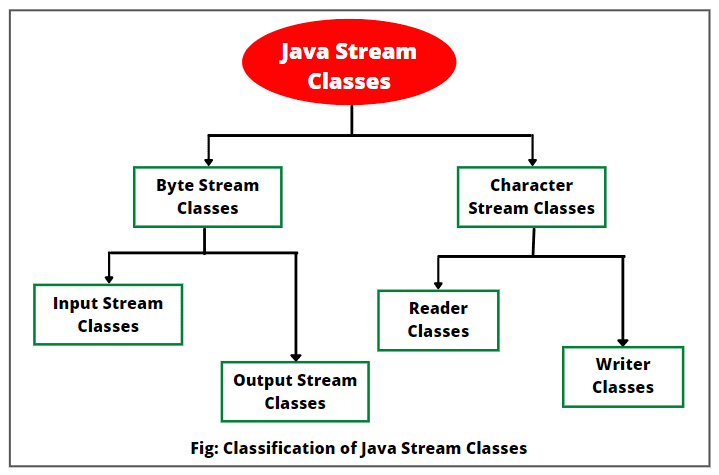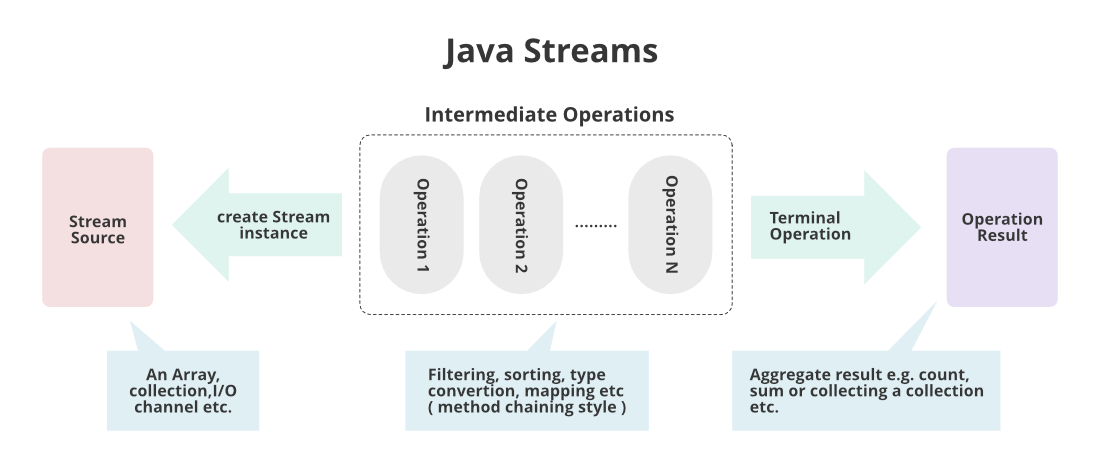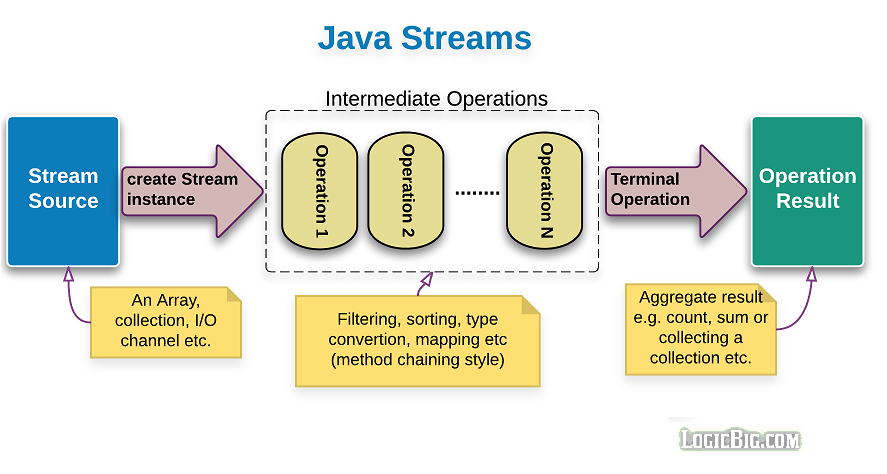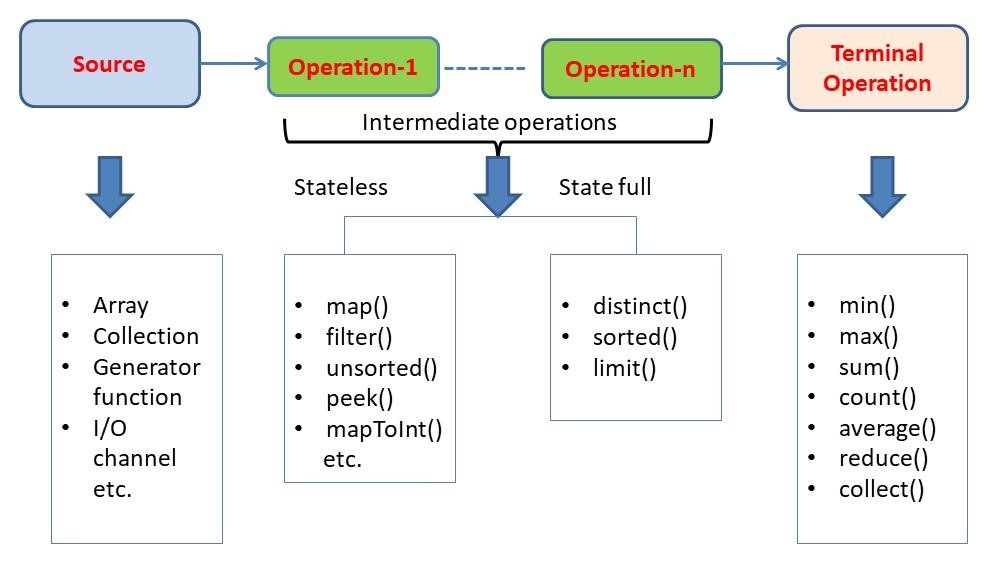The basic input and output stream and the streams introduced in Java 8Stream API. Modern versions of Java platform define two types of IO streams.
A In Depth Guide To Java 8 Stream Api Java2blog
Java Streams with Examples.

. Its also worth noting that operations on streams dont change the source. In the following example we are using reduce method which is used to sum of all the product prices. Byte Stream Character Stream.
Java 8 in action. The first field is used to store the data and the second field is. They are used for reading or writing to binary data IO.
Following are the various types of linked list. As easy as it can be. Stream In Java.
It is basically used to send outwrite the data to destination. Java 8 streams allow developers to extract precise data from a large collection using a set of predefined operations. Intermediate operations Terminal operations Short-circuit operations.
Java Stream Example. Depending upon the data a stream holds it can be classified into. Reduce Method in Collection.
Streamiterate is a function that creates an infinite stream by taking a seed starting point and a UnaryOperator for which you can pass in a Lambda expression. Byte streams in Java are designed to provide a convenient way for handling the input and output of bytes ie units of 8-bits data. The intermediate operations such as limit filter map etc.
Unlike Collection stream provide internal iteration and multiple streams can be. There are many types of streams. It provides a convenient means for handling input and output of byte.
However Java 8 introduced a stream that can be referred to as a set of. The names of the methods in both sets of classes are almost identical except for the suffix that is character- stream classes end with the suffix Reader or Writer and byte- stream classes end with the suffix InputStream and OutputStream. Java IO Stream Byte Stream.
What are the two types of Streams offered by java 8. Starting at four this particular iteration will. Long count liststream distinct count.
Output Stream Output stream represent a destination source. They are divided into intermediate operations return Stream and terminal operations return a result of definite type. Basically there are two types of streams in Java.
Int x ReadIntreader. The methods for character streams generally accept parameters of data type char while byte streams work with byte data types. A sequential and parallel b sequential and random c parallel and random d random and synchronized I had been asked this question in an interview.
Discussed types of linked list. Lets start to learn stream operations on a list. Return streams on which you can perform further processing.
Input represents the flow of data into a program. Intermediate operations allow chaining. A stream is not a data structure instead it takes input from the Collections Arrays or IO channels.
And the beauty continues as you can use any kind of input source as long as you can build a stream wrapper for it. In is an instance of the input stream. This method takes a sequence of input elements and combines them into a single summary result by repeated operation.
A Streams represents a sequence of elements and supports different kind of operations to perform computations upon those elements. Singly linked list Doubly linked list Circular linked list Doubly Circular linked list See Complete PlaylistsPlacement Se. Stream is a a sequence of elements from a source that supports data processing operations.
For example a stream might be aninput character-oriented processing stream. It is used to read the binary data from the source. StreamReader reader new StreamReaderstream.
Byte Streams Byte stream is used to input and output. With Java 8 Collection interface has two methods to generate a Stream. As discussed earlier streams in Java are mainly categorized into two broad categories - intermediate and terminal operations.
For example finding the sum of numbers or accumulating elements into a list. The input stream connects data source and a Java program as shown in the below figure. A stream is a sequence of objects that supports various methods which can be pipelined to produce the desired result.
Heres a quick example. There are broadly 3 types of operations that are carried over streams namely as follows as depicted from the image shown above. The above asked question is from Java 8 Features topic in division Autoboxing Miscellaneous of Java Select the correct answer from above.
Before the release of Java 8 using the term stream in Java would automatically be associated with IO. A character-oriented stream or a byte-oriented stream and may be connected to a variety of sources or destinations. Introduced in Java 8 the Stream API is used to process collections of objects.
A stream that receives or reads data from a data source and sends it to a Java program is called input stream. It provides a convenient means for handling input and output of characters. In Java two types of streams are involved.
Types of Stream Stream is basically divided into following types based on data flow direction. And terminal operations mark the completion of a stream. Stream stream new NetworkStreammySocket.
They are as follows. Cut your Java code in half using streams. Input Stream Input stream is represented as an input source.
Assume that we have a list of integers from 1 to 10 and we will do a filter of the odd numbers in this list then limit the execution of the elements after the 4th element then transform the filtered elements by multiplying 2 and then finally print them.

Java 8 Stream Tutorial Geeksforgeeks


0 Comments